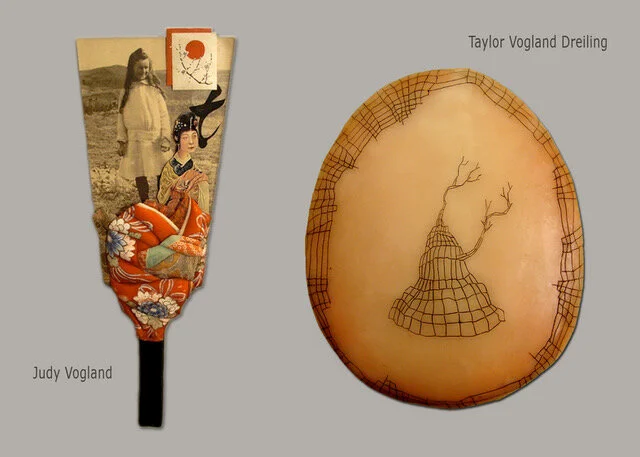Bare Bones & Thrown Stones
Primitive and playful art will fill Lincoln City’s Chessman Gallery for “Bare Bones & Thrown Stone,” a new show opening Friday, Aug. 14, with works by Judy Vogland, Taylor Ryder and Patrick Horsley.
Longtime Oregon mixed media painter and surface maker, Judy Vogland, and artist daughter, Taylor Ryder, of Pacifica, California, each breathe life into narrative assumptions and juxtapositions of everyday life from individual points of view.
Oregon clay master, Patrick Horsley, creates architecturally directed pieces that speak of primitive and contemporary references from temple and home.
In lieu of an opening reception, take a live virtual tour of the gallery at 4 pm on Friday, Aug. 14, on the Lincoln City Cultural Center’s Facebook page. Gallery Director Krista Eddy and Executive Director Niki Price will walk you through the new show and provide lighthearted commentary and behind the scenes details.
Growing up in the ’50s and ’60s, Vogland’s Norwegian family history of fishing
primes her passion for the quirks of watery crafty characters especially exploring what one does while “waiting” to fish.
In her most recent work, Vogland searches fantasized, funky, forced and often funny relationships found and then developed while exploring the historical archives of Oregon coastal loggers and fishermen. While gathering the vintage discards of lives past, she plays with secret things found, often reinventing lively stories and poking fun at the humorous hijinks found in everyday life, like stacking logs and pulling fish.
“Bare Bones & Thrown Stone” also explores the destruction and parallels of environmental interruption brought on by logging practices from 1900 to 1955. The effects of Oregon’s historic Tillamook Burn still linger in Vogland’s memory from family beach trips taken in the family’s ‘48 Chevrolet. Vogland has always loved trees and explores the outcome of the Burn through a variety of materials redefining the truth and bringing up new situations by exposing the old.
A surface maker and long practiced Oregon painter and art teacher, Vogland still shows up in the studio every day at 9 am. Her daily practice has carried her through more than five decades of studio work developing public and private space commissions including creating a variety of gallery shows throughout the Pacific Northwest since the late ’60s. For two decades, she designed and developed public-space fabric sculpture installations across the United States but the past three decades have been focused on painting and collage, with water-based mixed media surfaces exploring found and familiar materials including crusty beach sand. She invents surfaces that are layered with visual stories filled with treasures and by-products of life’s journeys.
Acknowledging the power of place, Vogland has taught a workshop for 42 continuous summers, beginning at Hillsboro High School, moving to Portland State University’s Haystack Program and now at Sitka Center for Art and Ecology, where she is sharing her love for mixed media surfaces using sand somewhere on the Oregon Coast.
Taylor Ryder is also a previous artist in residence at the Sitka Center, and has had previous joint exhibitions with her artist mother. Lately, she says she is “interested in the small dramas and upheavals that play out within the home and the fallout they produce.” She has shown at galleries including the Beppu Wiarda Gallery in Portland.
Patrick Horsely moved to Portland, Oregon in the ’70s and graduated from Portland Art Museum School.
He makes a lot of pots that aren’t utilitarian and makes vases and platters where the function is more aesthetic, but focuses on making the thing that is true to himself.
Horsely draws on lots of influences from Oregon’s natural places, including the columnar basalt in the Columbia Gorge. He enjoys the eastern side of the Oregon Cascades where all the basalt is exposed and loves the texture and the yellow-green lichen that grows on it.
His work is also strongly influenced by architecture, both primitive and contemporary. He bases his work on the idea of the container vessel, and at times, utilitarian forms such as teapots and lidded jars. Some of the work — bowls, vases and platters — fall into a more ceremonial category.
Horsely challenges himself to combine the many elements (handles, feet, spouts and lids) into a work that dances and presents a new view and image of a familiar form. Most of his work is thrown, or thrown then altered, with some of the pieces using slabs and thrown parts.
All the work is stoneware with glazes made with oxides from manganese and copper for colors from silver-black to purple-blues and green. The surfaces are semi-matte to very dry sculptural glazed surfaces.
“Bare Bones & Thrown Stones” will run through September 7 in the Chessman Gallery, inside the Lincoln City Cultural Center at 540 NE Hwy. 101. The center is open from 10 am to 4 pm, Thursday through Sunday. Masks and social distancing are required in the building.



